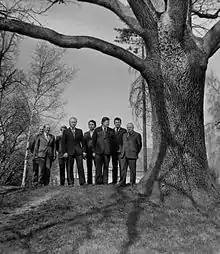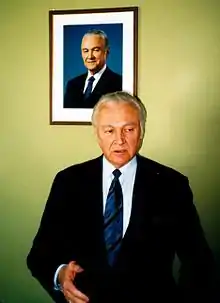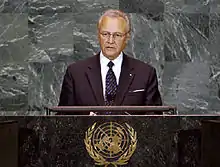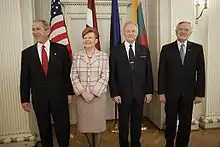Arnold Rüütel
Arnold Rüütel[lower-alpha 1] (born 10 May 1928)[1] is an Estonian politician. He was the third President of Estonia from 8 October 2001 to 9 October 2006. Rüütel was the second president of the country after the end of the 1944–1991 Soviet occupation, and the restoration of the independent Republic of Estonia on 20 August 1991.
Arnold Rüütel | |
|---|---|
 | |
| President of Estonia | |
| In office 8 October 2001 – 9 October 2006 | |
| Prime Minister | Mart Laar Siim Kallas Juhan Parts Andrus Ansip |
| Preceded by | Lennart Meri |
| Succeeded by | Toomas Hendrik Ilves |
| Chairman of the Supreme Council of Estonia | |
| In office 29 March 1990 – 5 October 1992 Estonian SSR: 29 March 1990 – 8 May 1990 | |
| Prime Minister | Edgar Savisaar Tiit Vähi |
| Preceded by | Enn-Arno Sillari |
| Succeeded by | Lennart Meri (President) |
| Chairman of the Presidium of the Supreme Soviet of the Estonian Soviet Socialist Republic | |
| In office 8 April 1983 – 29 March 1990 | |
| Prime Minister | Valter Klauson Bruno Saul Indrek Toome |
| First Secretary | Karl Vaino Vaino Väljas |
| Preceded by | Johannes Käbin |
| Succeeded by | Himself (Chairman of the Supreme Council) |
| Personal details | |
| Born | 10 May 1928 Pahavalla, Estonia |
| Political party | Communist Party (Before 1994) People's Union (1994–2001, 2007–2012) Independent (2001–2007) Conservative People's Party (2012–present) |
| Spouse | Ingrid Rüütel |
| Children | 2 |
| Signature |  |
Biography
Rüütel was born in Pahavalla village in Laimjala Parish, Saaremaa, Estonia. His parents were Feodor Rüütel (1900−1965) and Juulia Rüütel (1905−1990).[2][3] He graduated from the Agricultural College in Jäneda in 1949.

He worked as a senior agronomist in Saaremaa (1949−1950) and then as a teacher at the Tartu School of Agricultural Mechanization (1955−1957). In between those two jobs, he served his term in the Soviet Army. In 1957, he was appointed as the director of the experimental farm of the Research Institute of Veterinary Medicine and Animal Husbandry, and in 1963 he was appointed director of the Tartu Reference State Farm, remaining in this position until 1969. He graduated from the Estonian Academy of Agriculture in 1964. From 1969 to 1977, Rüütel was rector of the Estonian Academy of Agriculture. He served as the last chairman of the Presidium of the Supreme Soviet of the Estonian SSR (thus he was also one of the 15 deputy chairmen of the Supreme Soviet of the USSR) from 8 April 1983 to 29 March 1990.
On 29 March 1990 he was elected Chairman of the Supreme Council (head of parliament), after the first free elections in the then Soviet-occupied Estonia. He served in that position when Estonia restored full independence on 20 August 1991, and continued in office until 6 October 1992. In the independent Estonia, Rüütel was also a member of the Constitutional Assembly from 1991 to 1992, which drafted the new Constitution of the Republic of Estonia. He stood as a candidate in the first presidential election in 1992. In the first round, Rüütel received the best result, 43% of popular vote, but still short of required 50% majority. The second round was held in the parliament (Riigikogu), and there Rüütel lost to the presidential elections to Lennart Meri.

In 1991, Rüütel took his Doctorate in agriculture. He served as Chairman of the People's Union of Estonia from 1994 to 2000, and was elected as a member of parliament (Riigikogu), in 1995, where he acted as vice-chairman until 1997. He ran for president in the 1996 election (this time an indirect election with no popular vote) and lost to Meri once again.
Presidency

Rüütel was elected president by an electoral college on 21 September 2001, defeating Toomas Savi in the final round by votes of 186 to 155. Rüütel was inaugurated as President of the Republic on 8 October 2001. Rüütel announced in his election manifesto that his principal aims would be to reduce the negative effects that Estonia's speedy economic changes had had on a large number of people, and to seek greater solidarity within the society.
| List of diplomatic visits by Arnold Rüütel | ||
| City and Country | Dates | Notes |
|---|---|---|
| 6 November 2001 | Working visit.[4] | |
| 20-21 November 2001 | Official visit.[5] | |
| 15 January 2002 | Official visit.[6] | |
| 21 January 2005 | Working visit.[7] | |
The end of Rüütel's term was overshadowed by several controversies. At the Independence Day military parade on 24 February 2005, Rüütel repeatedly congratulated soldiers on 'Victory day' (Estonian Victory Day is on June 23), which caused speculation about the then 77-year-old president's mental health.[8] In January 2006, Estonian Television reported that Rüütel's underage granddaughters had organized a party in the presidential palace and drunk alcohol. Later that year, the newspaper Eesti Ekspress published archived documents suggesting that Rüütel as a top functionary of the Estonian SSR was involved in the persecution of scientist Johannes Hint (later sentenced to jail in a show trial) by the KGB.[9] Rüütel himself commented that he had tried to defend Hint.[10]
As Rüütel's term was due to end in October 2006, he announced on 7 June 2006 that he would be a candidate for re-election, thus ending speculation as to his candidacy.[11] In late August, the parliament failed to elect a President. The election of Ene Ergma and Toomas Hendrik Ilves by the parliament was blocked by Rüütel's supporters, who did not take out ballots. The electoral college met to vote for a president on September 23. The latest opinion polls (September 2006) had suggested that Rüütel's popular support was around 31 per cent (Ilves' support was 51%); Rüütel was more popular amongst the elderly and the Russian-speaking minority.[12] In the electoral college, Rüütel received 162 votes against 174 for Ilves. Rüütel congratulated the winner and offered his assistance. Rüütel's presidency therefore expired at the end of his term, and Ilves took office on 9 October 2006.
Later activities
Rüütel voiced support for Mart Helme of the Conservative People's Party of Estonia in the 2016 Estonian presidential election.[13][14] Since leaving office, he has continued to meet with his former counterparts, including Kazakh president Nursultan Nazarbayev[15] and Moldovan president Petru Lucinschi.[16]
Awards
 Soviet Union: Order of the Badge of Honour (1964)
Soviet Union: Order of the Badge of Honour (1964) Soviet Union: Order of Lenin (1971)
Soviet Union: Order of Lenin (1971) Soviet Union: Order of Friendship of Peoples (1981)
Soviet Union: Order of Friendship of Peoples (1981) Estonia: Collar of the Order of the Cross of Terra Mariana (2001)[17]
Estonia: Collar of the Order of the Cross of Terra Mariana (2001)[17] Estonia: Collar of the Order of the National Coat of Arms (2008)[18]
Estonia: Collar of the Order of the National Coat of Arms (2008)[18] Finland: Grand Cross of the Order of the White Rose with collar (2001)
Finland: Grand Cross of the Order of the White Rose with collar (2001) Norway: Grand Cross of the Order of St. Olav (2002)[19]
Norway: Grand Cross of the Order of St. Olav (2002)[19] Poland: Great Cross of the Order of the White Eagle[20]
Poland: Great Cross of the Order of the White Eagle[20] Portugal: Grand Collar of the Order of Prince Henry (2003) [21]
Portugal: Grand Collar of the Order of Prince Henry (2003) [21] Luxembourg: Great Cross of the Order of Adolphe of Nassau (2003)
Luxembourg: Great Cross of the Order of Adolphe of Nassau (2003) Iceland: Knight Grand Cross of the Order of the Falcon (2004)
Iceland: Knight Grand Cross of the Order of the Falcon (2004) Slovakia: Grand Cross (or 1st Class) of the Order of the White Double Cross (2005)[22]
Slovakia: Grand Cross (or 1st Class) of the Order of the White Double Cross (2005)[22] Portugal: Grand Collar of the Order of Saint James of the Sword (2006)[21]
Portugal: Grand Collar of the Order of Saint James of the Sword (2006)[21] Italy: Knight Grand Cross with Grand Cordon of the Order of Merit of the Italian Republic[23]
Italy: Knight Grand Cross with Grand Cordon of the Order of Merit of the Italian Republic[23] Latvia: Commander Grand Cross with Chain of the Order of Three Stars
Latvia: Commander Grand Cross with Chain of the Order of Three Stars Lithuania: Grand Cross with Golden Chain of the Order of Vytautas the Great (30 September 2004)[24]
Lithuania: Grand Cross with Golden Chain of the Order of Vytautas the Great (30 September 2004)[24] Philippines: Gusi Peace Prize for Statesmanship (27 November 2013)[25]
Philippines: Gusi Peace Prize for Statesmanship (27 November 2013)[25]
Gallery

 Rüütel with Albert II and Queen Paola of Belgium, Prince Henrik of Denmark, Bernadette Chirac, President Jorge Sampaio of Portugal, President George W. Bush and First Lady Laura Bush of the United States, and President Gloria Macapagal Arroyo of the Philippines at the funeral of John Paul II.
Rüütel with Albert II and Queen Paola of Belgium, Prince Henrik of Denmark, Bernadette Chirac, President Jorge Sampaio of Portugal, President George W. Bush and First Lady Laura Bush of the United States, and President Gloria Macapagal Arroyo of the Philippines at the funeral of John Paul II..jpg.webp) Arnold Rüütel with Vladimir Putin and Patriarch Alexy II in January 2005.
Arnold Rüütel with Vladimir Putin and Patriarch Alexy II in January 2005. Arnold Rüütel and his wife Ingrid Rüütel at the XXV Estonian Song Festival (Laulupidu) in 2009.
Arnold Rüütel and his wife Ingrid Rüütel at the XXV Estonian Song Festival (Laulupidu) in 2009. Conference dedicated to Arnold Rüütel in 2013
Conference dedicated to Arnold Rüütel in 2013
Notes
- Estonian pronunciation: [ˈɑrnolʲd ˈryːtːːel]
References
- East, Roger; Thomas, Richard J. (June 3, 2014). Profiles of People in Power: The World's Government Leaders. Routledge. ISBN 9781317639404. Retrieved February 17, 2022 – via Google Books.
- Pao, Bruno (May 10, 2018). "Arnold Rüütel 90" (in Estonian). Meie Maa. Archived from the original on May 14, 2021. Retrieved February 2, 2020.
- "ARNOLD RÜÜTEL, President of the Republic of Estonia". The President of the Republic of Estonia. Retrieved February 2, 2020.
- "The President of the Republic of Estonia 2001-2006: Working visit to Republic of Poland 6.11.2001". Vp2001-2006.president.ee. Retrieved February 17, 2022.
- "The President of the Republic of Estonia 2001-2006: State Visit to the Republic of Finland 20.-21.11.2001". Vp2001-2006.president.ee. Retrieved February 17, 2022.
- "The President of the Republic of Estonia 2001-2006: State Visit to the Republic of Finland 20.-21.11.2001".
- "The President of the Republic of Estonia 2001-2006: The President of the Republic met with Patriarch Alexy II". Vp2001-2006.president.ee.
- "REIN TAAGEPERA: Meil on õigus teada – Eesti Päevaleht Online". Archived from the original on September 26, 2007. Retrieved September 24, 2006.
- "Eesti Ekspress / Rüütel käsutas KGB Desintegraatori kallale". Archived from the original on September 27, 2007. Retrieved September 8, 2006.
- The President of the Republic of Estonia 2001–2006: Statement of the President of the Republic of Estonia on 5 September 2006 Archived September 27, 2007, at the Wayback Machine
- "Rüütel kandideerib teiseks ametiajaks". Delfi.ee. Retrieved February 17, 2022.
- "Ilves suurendas oma edumaad Rüütli ees – Eesti Päevaleht Online". Archived from the original on September 26, 2007. Retrieved September 25, 2006.
- "Arnold Rüütel toetab presidendiks Mart Helmet". Delfi. Retrieved 30 November 2017.
- "Arnold Rüütel peab parimaks presidendikandidaadiks Mart Helmet". Ohtuleht.ee. Retrieved 30 November 2017.
- "Глава государства Нурсултан Назарбаев принял экс-президента Эстонской Республики Арнольда Рюйтеля. — Официальный сайт Президента Республики Казахстан". Archived from the original on September 8, 2019. Retrieved February 5, 2021.
- "Former Estonian president sends message on support of Moldova's European aspirations". President.md. Retrieved 2020-11-03.
- "Vabariigi President". President.ee. Retrieved 2019-08-17.
- "Vabariigi President". President.ee. Retrieved 2019-08-17.
- "Tildelinger av ordener og medaljer". Kongehuset.no (in Norwegian). Retrieved 2019-08-17.
- "Postanowienie Prezydenta Rzeczypospolitej Polskiej z dnia 12 marca 2002 r. o nadaniu orderu". Prawo.sejm.gov.pl. Retrieved 2019-08-17.
- "ENTIDADES ESTRANGEIRAS AGRACIADAS COM ORDENS PORTUGUESAS - Página Oficial das Ordens Honoríficas Portuguesas". Ordens.presidencia.pt. Retrieved February 17, 2022.
- Slovak republic website, State honours Archived April 13, 2016, at the Wayback Machine : 1st Class received in 2005 (click on "Holders of the Order of the 1st Class White Double Cross" to see the holders' table)
- "Le onorificenze della Repubblica Italiana". Quirinale.it. Retrieved 2019-08-17.
- Lithuanian Presidency Archived April 19, 2014, at the Wayback Machine, Lithuanian Orders searching form
- "President Arnold Rüütel pälvis Gusi rahupreemia riigimehelikkuse kategoorias". Delfi.ee. Retrieved February 17, 2022.
